Nuclear keratin 6A upregulates human papillomavirus oncogene expression through TEAD1 interaction
- PMID: 40544293
- PMCID: PMC12181915
- DOI: 10.1186/s12985-025-02832-5
Nuclear keratin 6A upregulates human papillomavirus oncogene expression through TEAD1 interaction
Abstract
Background: Human papillomavirus (HPV) oncogenes, E6 and E7, play a critical role in cervical carcinogenesis, and their expression is regulated by cellular transcription factors bound to the long control region (LCR) in the HPV genome. To elucidate the mechanisms of HPV-induced carcinogenesis, it is important to identify host factors that control the LCR in cervical cancer cells. We previously reported that the LCR-bound transcription factor TEAD1 is critical for HPV oncogene expression. Here, we aimed to elucidate the role of stress-responsive keratin 6A (K6A), a potential cofactor for TEAD1, in HPV oncogene expression.
Methods: HPV16-positive cervical cancer cells were transfected with small interfering RNA (siRNA) or infected with a lentivirus expressing short hairpin RNA (shRNA) to downregulate the expression of K6A. HPV16 oncogene expression was examined by reverse transcription-quantitative polymerase chain reaction or Western blotting. Retroviral transduction was used to rescue the expression of K6A in K6A-depleted cells. Subcellular localization of K6A was analyzed by cellular fractionation followed by Western blotting. Chromatin immunoprecipitation (ChIP) assay was used to evaluate in vivo binding of K6A to the LCR. The physical interaction between K6A and TEAD1 was assessed by co-immunoprecipitation and fluorescence-based in vivo interaction assays.
Results: Transfection of siRNA against K6A decreased levels of HPV16 E6*I mRNA and E7 protein in cervical cancer cells. Lentiviral delivery of shRNA against K6A also reduced E7 protein level and suppressed cell growth. Conversely, ectopic expression of shRNA-resistant K6A in the K6A-depleted cells restored E7 expression, and further siRNA knockdown of TEAD1 in the K6A-rescued cells attenuated E7 expression. K6A was detected in the nuclear fraction of cervical cancer cells with a functional bipartite nuclear localization signal in its N-terminus. ChIP assay showed that nuclear K6A bound to the HPV16 LCR in vivo, partially depending on the presence of the TEAD transcription factors. Finally, protein-protein interaction assays confirmed the association of K6A with TEAD1 in the nucleus.
Conclusions: Nuclear K6A associates with the LCR via TEAD1 and upregulates HPV16 oncogene expression, thereby contributing to cervical cancer development.
Supplementary Information: The online version contains supplementary material available at 10.1186/s12985-025-02832-5.
Keywords: Cervical cancer; Gene expression; Human papillomavirus; Keratin 6A; Viral oncogene.
Conflict of interest statement
Declarations. Ethics approval and consent to participate: Not applicable. Consent for publication: Not applicable. Competing interests: The authors declare no competing interests.
Figures
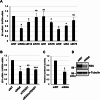
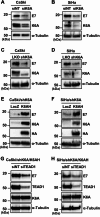

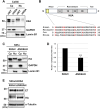
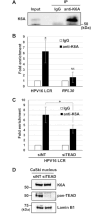
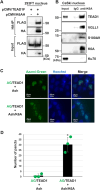
Similar articles
-
Nuclear proinflammatory cytokine S100A9 enhances expression of human papillomavirus oncogenes via transcription factor TEAD1.J Virol. 2023 Aug 31;97(8):e0081523. doi: 10.1128/jvi.00815-23. Epub 2023 Aug 14. J Virol. 2023. PMID: 37578237 Free PMC article.
-
The Transcriptional Cofactor VGLL1 Drives Transcription of Human Papillomavirus Early Genes via TEAD1.J Virol. 2020 May 4;94(10):e01945-19. doi: 10.1128/JVI.01945-19. Print 2020 May 4. J Virol. 2020. PMID: 32132238 Free PMC article.
-
Human Papillomavirus 16 E6 Upregulates APOBEC3B via the TEAD Transcription Factor.J Virol. 2017 Feb 28;91(6):e02413-16. doi: 10.1128/JVI.02413-16. Print 2017 Mar 15. J Virol. 2017. PMID: 28077648 Free PMC article.
-
Transformation of human urothelial cells (UROtsa) by as and cd induces the expression of keratin 6a.Environ Health Perspect. 2008 Apr;116(4):434-40. doi: 10.1289/ehp.10279. Environ Health Perspect. 2008. PMID: 18414623 Free PMC article.
-
Global Variation of Human Papillomavirus Genotypes and Selected Genes Involved in Cervical Malignancies.Ann Glob Health. 2015 Sep-Oct;81(5):675-83. doi: 10.1016/j.aogh.2015.08.026. Ann Glob Health. 2015. PMID: 27036725 Review.
References
-
- International Agency for Research on Cancer. Cervical Cancer. https://www.iarc.who.int/cancer-type/cervical-cancer/. Accessed 28 February 2025.
-
- Perkins RB, Wentzensen N, Guido RS, Schiffman M. Cervical cancer screening: A review. JAMA. 2023;330:547–58. - PubMed
-
- Boccardo E, Lepique AP, Villa LL. The role of inflammation in HPV carcinogenesis. Carcinogenesis. 2010;31:1905–12. - PubMed
Grants and funding
LinkOut - more resources
Full Text Sources

